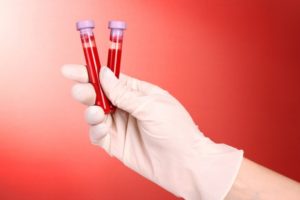Eosinophilic Esophagitis Samples
Bay Biosciences provides high quality, clinical grade, FFPE biopsy tissue blocks bio-specimens and matched cryogenically preserved sera (serum), plasma and peripheral blood mononuclear cells (PBMC) biofluid samples from patients diagnosed with eosinophilic esophagitis.
The sera (serum), plasma and PBMC biofluid specimens are processed from eosinophilic esophagitis patient’s peripheral whole-blood using customized collection and processing protocols. The eosinophilic esophagitis biopsy tissue and matched biofluid samples are collected from unique patients diagnosed with eosinophilic esophagitis and are provided to a valued pharmaceutical customer for research, diagnostics, discovery and drug development.
Detailed clinical data, patients history, symptoms, complete blood count (CBC), serology, MRI, biopsy tissue, histopathology information, elevated biomarker levels, genetic and metabolic information associated with eosinophilic esophagitis specimens is provided to a valued customer for research, development and drug discovery.
The eosinophilic esophagitis sera (serum), plasma and peripheral blood mononuclear cells (PBMC) biofluid are processed from patients peripheral whole-blood using customized collection and processing protocols.

Eosinophilic Esophagitis Overview
Eosinophilic esophagitis has been identified only since the early 90s, but is now considered a major cause of digestive system (gastrointestinal) illness. Research is ongoing and will likely lead to revisions in the diagnosis and treatment of eosinophilic esophagitis.
Signs and Symptoms of Eosinophilic Esophagitis
Signs and symptoms of eosinophilic esophagitis may vary from one individual to another and may differ depending on age. Infants and toddlers often refuse their food or have trouble growing properly. School-age children may have recurring abdominal pain, trouble swallowing, or vomiting. Adolescents and adults most often have difficult or painful swallowing. Their esophagus may narrow and cause food to become stuck (impaction), causing a medical emergency. Symptoms also may vary given the developmental ability and communication skills of the age group affected.
Following are the common symptoms of eosinophilic esophagitis:
- Reflux that does not respond to medication (acid suppressors). In infants, children, adults
Difficulty swallowing (dysphagia). In children and adults - Food impactions (food gets stuck in the esophagus) In older children and adults
- Nausea and Vomiting in infants, children and adults
- Failure to thrive (poor growth, malnutrition, or weight loss) and poor appetite. In infants, children, rarely in adults
- Abdominal pain or chest pain that is often centrally located and does not respond to antacids. In children and adults
- Feeding refusal/intolerance or poor appetite in infants and children
- Difficulty sleeping due to chest or abdominal pain, reflux, and/or nausea, in infants, children and adults
- Backflow of undigested food (regurgitation)
Following are the common symptoms of eosinophilic esophagitis in Children:
- Difficulty feeding, in infants
- Difficulty eating, in children
- Vomiting
- Abdominal pain
- Difficulty swallowing (dysphagia)
- Food getting stuck in the esophagus after swallowing (impaction)
- No response to GERD medication
- Failure to thrive (poor growth, malnutrition and weight loss)
Causes of Eosinophilic Esophagitis
Eosinophils are a normal type of white blood cells present in your digestive tract. However, in eosinophilic esophagitis, you have an allergic reaction to an outside substance. The reaction may occur as follows:
- Reaction of the esophagus: The lining of your esophagus reacts to allergens, such as food or pollen.
- Multiplication of eosinophils: The eosinophils multiply in your esophagus and produce a protein that causes inflammation.
- Damage to the esophagus: Inflammation can lead to scarring, narrowing and formation of excessive fibrous tissue in the lining of your esophagus.
- Dysphagia and impaction: You may have difficulty swallowing (dysphagia) or have food become stuck when you swallow (impaction).
- Additional symptoms: You may have other symptoms, such as chest pain or stomach pain.
There has been a significant increase in numbers of people diagnosed with eosinophilic esophagitis in the past decade. At first, researchers thought this was due to an increase in awareness among doctors and greater availability of tests. However, studies now suggest that the disease is becoming increasingly common, parallel to the increase in asthma and allergies.

Risk Factors of Eosinophilic Esophagitis
The following risk factors are associated with eosinophilic esophagitis:
- Climate: Patients who live in a cold or dry climate are more likely than those in other climates to be diagnosed with eosinophilic esophagitis.
- Season: You’re more likely to be diagnosed between the spring and fall, probably because levels of pollen and other allergens are higher and people are more likely to be outdoors.
- Sex: Eosinophilic esophagitis is more common in males than in females.
- Family history: Doctors think that eosinophilic esophagitis may run in the family (have a genetic
component). If your family members have eosinophilic esophagitis, you have a greater chance of being diagnosed with the disease. - Allergies and asthma: If you have food or environmental allergies, asthma, atopic dermatitis, or a chronic respiratory disease, you’re more likely to be diagnosed with eosinophilic esophagitis.
- Age: Originally, eosinophilic esophagitis was thought to be a childhood disease, but now it is known to be common in adults as well. The symptoms differ somewhat between children and adults.
Complications of Eosinophilic Esophagitis
In some patients, eosinophilic esophagitis can lead to the following complications:
- Scarring and narrowing of the esophagus: This makes it difficult to swallow and more likely that you will have food get stuck in the esophagus.
- Damage to the esophagus: Because of inflammation of the esophagus, endoscopy can cause perforation or tears in the tissue that lines the esophagus. Tearing can also occur in connection with retching that some people experience when they get food stuck in the esophagus.
Diagnosis of Eosinophilic Esophagitis
Your doctor will consider both your symptoms and test results to diagnose eosinophilic esophagitis. This will include determining whether you have gastroesophageal reflux disease (GERD).
Following tests are performed to diagnose eosinophilic esophagitis:
- Upper endoscopy: Your doctor will use a long narrow tube (endoscope) containing a light and tiny camera and insert it through your mouth down the esophagus. The doctor will inspect the lining of your esophagus for inflammation and swelling, horizontal rings, vertical furrows, narrowing (strictures), and white spots. Some people with eosinophilic esophagitis will have an esophagus that looks normal.
- Biopsy: During an endoscopy, your doctor will perform a biopsy of your esophagus. A biopsy involves taking a small bit of tissue. Your doctor will likely take multiple biopsy tissue samples from your esophagus and then examine the tissue under a microscope for eosinophils.
- Blood tests: If doctors suspect eosinophilic esophagitis, you may undergo some additional tests to confirm the diagnosis and to begin to look for the sources of your allergic reaction (allergens). You may be given blood tests to look for higher than normal eosinophil counts or total immunoglobulin E levels, suggesting an allergy.
- Esophageal sponge: This test is performed in the doctor’s office and involves swallowing a capsule attached to a string. The capsule will dissolve in your stomach and release a sponge that the doctor will pull out your mouth with the string. As the sponge is pulled out, it will sample the esophageal tissues and allow the doctor to determine the degree of inflammation in your esophagus without having to undergo endoscopy.

Bay Biosciences is a global leader in providing researchers with high quality, clinical grade, fully characterized human tissue samples, bio-specimens and human bio-fluid collections from cancer (tumor) tissue, cancer serum, cancer plasma cancer PBMC and human tissue samples from most other therapeutic areas and diseases.
Bay Biosciences maintains and manages it’s own bio-repository, human tissue bank (biobank) consisting of thousands of diseased samples (specimens) and from normal healthy donors available in all formats and types. Our biobank procures and stores fully consented, deidentified and institutional review boards (IRB) approved human tissue samples and matched controls.
All our human human tissue collections, human specimens and human bio-fluids are provided with detailed samples associated patient’s clinical data. This critical patient’s clinical data includes information relating to their past and current disease, treatment history, lifestyle choices, biomarkers and genetic information. Patient’s data is extremely valuable for researchers and is used to help identify new effective treatments (drug discovery & development) in oncology, other therapeutic areas and diseases. This clinical information is critical to demonstrate their impact, monitor the safety of medicines, testing & diagnostics, and generate new knowledge about the causes of disease and illness.
Bay Biosciences banks wide variety of human tissue samples and biological samples including cryogenically preserved -80°C, fresh, fresh frozen tissue samples, tumor tissue samples, FFPE’s, tissue slides, with matching human bio-fluids, whole blood and blood derived products such as serum, plasma and PBMC’s.
Bay Biosciences is a global leader in collecting and providing human tissue samples according to the researchers specified requirements and customized, tailor made collection protocols. Please contact us anytime to discuss your special research projects and customized human tissue sample requirements.
Bay Biosciences provides human tissue samples (human specimens) from diseased and normal healthy donors; including peripheral whole-blood, amniotic fluid, bronchoalveolar lavage fluid (BAL), sputum, pleural effusion, cerebrospinal fluid (CSF), serum (sera), plasma, peripheral blood mononuclear cells (PBMC’s), saliva, Buffy coat, urine, stool samples, aqueous humor, vitreous humor, kidney stones, renal calculi, nephrolithiasis, urolithiasis and other bodily fluids from most diseases including cancer. We can also procure most human bio-specimens and can do special collections and requests of human samples that are difficult to find. All our human tissue samples are procured through IRB approved clinical protocols and procedures.
In addition to the standard processing protocols Bay Biosciences can also provide human plasma, serum, PBMC bio-fluid samples using custom processing protocols, you can buy donor specific sample collections in higher volumes and specified sample aliquoting from us. Bay Biosciences also provides human samples from normal healthy donors, volunteers, for controls and clinical research, contact us Now.
日本のお客様は、ベイバイオサイエンスジャパンBay Biosciences Japanまたはhttp://baybiosciences-jp.com/contact/までご連絡ください。


